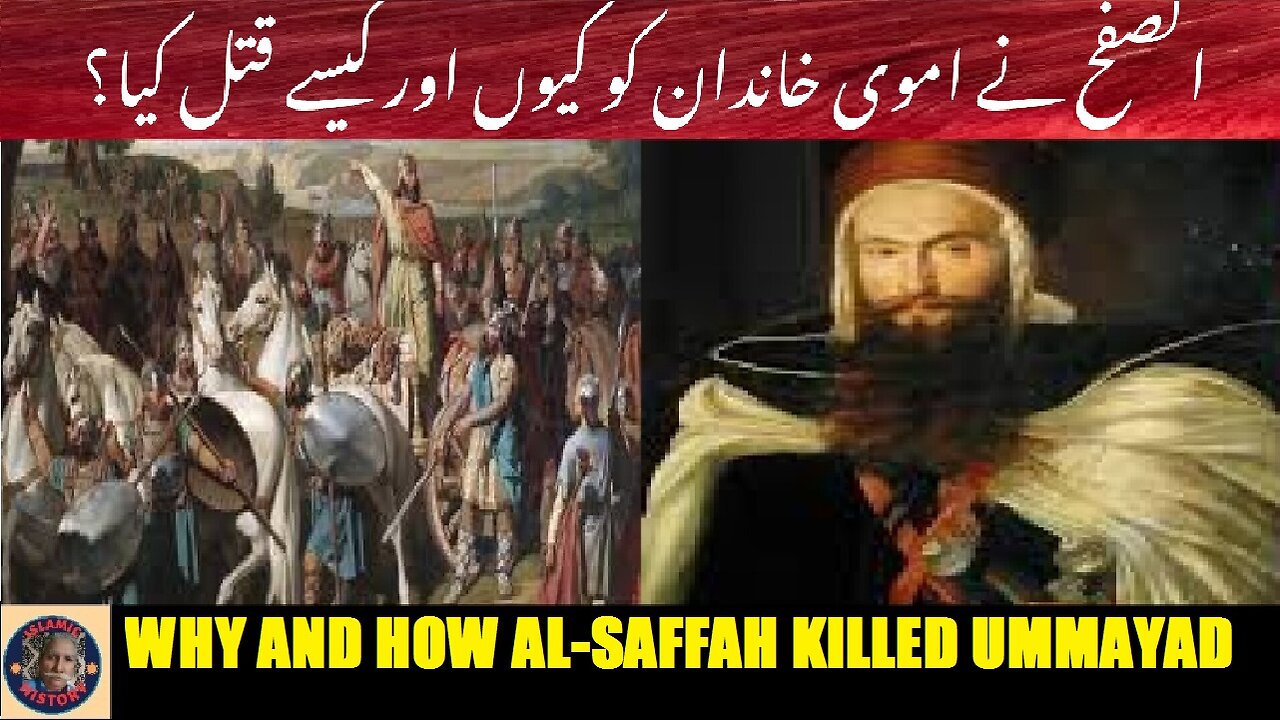Premium Only Content

Why and how Al-Saffah killed Umayyad family | الصفح نے اموی خاندان کو کیوں اور کیسے قتل کیا
@islamichistory813 #HistoricalAnalysis #PowerStruggles #MiddleEasternHistory
Why and how Al-Saffah killed Umayyad family?
Dekhti Aankhooon aur sountay kaanoon ko Asslamoalaikum, sisters, brothers friends and elders, In this informative video, we are describing the brutal rise of Al-Saffah and the systematic extermination of the Umayyad family, that Why and how Al-Saffah killed Umayyad family? By analyzing the historical backdrop and the key players involved, we aim to provide a comprehensive understanding of why Al-Saffah resorted to such drastic measures.
Later tales recount that, concerned that there would be a return of rival Umayyad power, as-Saffah invited all of the remaining members of the Umayyad family to a dinner party where he had them clubbed to death before the first course, which was then served to the hosts. The only survivor, Abd al-Rahman ibn Mu'awiya, escaped to the province of al-Andalus (Spain), where the Umayyad dynasty would endure for three more centuries in the form of the Emirate of Córdoba and the subsequent Caliphate of Córdoba. Another version is that as-Saffah's new governor to Syria, 'Abd Allah ibn 'Ali, hunted down the last of the family dynasty, with only Abd al-Rahm?n escaping. Ultimately, 'Abbasid rule was accepted even in Syria, and the beginning of the new Islamic dynasty was considered "free from major internal dissensions."
As-Saffah's four-year reign was marked with efforts to consolidate and rebuild the caliphate. His supporters were represented in the new government, but apart from his policy toward the Umayyad family, as-Saffah is widely viewed by historians as having been a mild victor. Jews, Nestorian Christians, and Persians were well represented in his government and in succeeding Abbasid administrations. Education was also encouraged, and the first paper mills, staffed by skilled Chinese prisoners captured at the Battle of Talas, were set up in Samarkand.
Equally revolutionary was as-Saff?h's reform of the army, which came to include non-Muslims and non-Arabs in sharp contrast to the Umayyads who refused any soldiers of either type. As-Saffah selected the gifted Abu Muslim as his military commander, an officer who would serve until 755 in the Abbasid army.
Not all Muslims accept the legitimacy of his caliphate, however. According to later Shi'ites, as-Saffah turned back on his promises to the partisans of the Alids in claiming the title caliph for himself. The Shi'a had hoped that their imam would be named head of the caliphate, inaugurating the era of peace and prosperity the millennialists had believed would come. The betrayal alienated as-Saff?h's Shi'a supporters, although the continued amity of other groups made Abbasid rule markedly more solvent than that of the Umayyads.
Caliph Abu al-`Abbas `Abdu’llah as-Saffah died of smallpox on 8 June 754 (13 Dhu al-Hijja 136 AH), only four years after taking the title of caliph. Before he died, as-Saffah appointed his brother Abu Ja'far al-Mansur[1] and, following him, the caliph's nephew Isa ibn Musa as his successors; ibn Musa, however, never filled the position.
During his reign a great battle took place in 751 known as the Battle of Talas or Battle of Artlakh was a military engagement between the Abbasid Caliphate along with their ally the Tibetan Empire against the Chinese Tang dynasty. In July 751 AD, Tang and Abbasid forces met in the valley of the Talas River to vie for control over the Syr Darya region of central Asia. After several days of stalemate, the Karluk Turks originally allied to the Tang defected to the Abbasids and tipped the balance of power, resulting in a Tang rout.
The defeat marked the end of Tang westward expansion and resulted in Muslim control of Transoxiana for the next 400 years. Control of this region was economically beneficial for the Abbasids because it was on the Silk Road. Historians debate whether or not Chinese prisoners captured in the aftermath of the battle brought paper-making technology to the Middle East, where it eventually spread to Europe.
The numbers of combatants involved in the Battle of Talas are not known with certainty; however, various estimates exist. The Abbasid army (200,000 Muslim troops according to Chinese estimates, though these numbers may be greatly exaggerated) which included contingents from their Tibetan ally met the combined army of 10,000 Tang Chinese and 20,000 Karluk mercenaries (Arab records put the Chinese forces at 100,000 which also may be greatly exaggerated).
So sisters brothers friends and elders, tomorow we are going to described War between Abbasid and Chinese Force and death of Al-Saffah. Allah hafiz
=================================
-
 1:47
1:47
ISLAMIC HISTORY
1 hour agoSurah At Taubah Verse No 92 تلاوت َسورة اَلتَّوْبَة اردو اور انگریزی ترجمے کے ساتھ آیت نمبر
1 -
 LIVE
LIVE
Inverted World Live
2 hours agoMan Sees Creature in Loch Ness | Ep. 116
693 watching -
 LIVE
LIVE
Laura Loomer
3 hours agoEP146: Loomer EXPOSES Big Tech's Complicity With Anti-ICE Violence
874 watching -
 2:04:52
2:04:52
TimcastIRL
2 hours agoBomb Threat At TPUSA, Bomb Squad Deployed For Controlled Detonation | Timcast IRL
98.9K101 -
 LIVE
LIVE
Barry Cunningham
2 hours agoBREAKING NEWS: DEMOCRATS SHUT DOWN THE GOVERNMENT! THEY HAVE UNLEASHED PRESIDENT TRUMP
2,634 watching -
 3:59:47
3:59:47
Nikko Ortiz
4 hours agoPTSD Is Fun Sometimes | Rumble LIVE
33K2 -
 23:02
23:02
Jasmin Laine
6 hours ago"Carney BROKE Ethics Laws!"—Liberal SPEECHLESS After Being Cornered On CTV
90215 -
 31:50
31:50
iCkEdMeL
2 hours ago $6.64 earnedMassive Protest Shuts Down Downtown Chicago Over ICE Crackdown
37.7K65 -
 17:17
17:17
Scammer Payback
7 hours agoHolding a Scammer's Computer HOSTAGE
7172 -
 LIVE
LIVE
Flyover Conservatives
9 hours agoWhy Christians Should Embrace the Term “Christian Nationalist” | FOC Show
213 watching